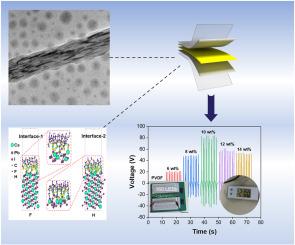Textured CsPbI3 nanorods composite fibers for stable high output piezoelectric energy harvester
IF 36.6
Q1 ELECTROCHEMISTRY
引用次数: 0
Abstract
The utilization of piezoelectric nanogenerator (PENG) based on halide perovskite materials has demonstrated significant promise for energy harvesting applications. However, the challenge of synthesizing halide perovskite materials with both high output performance and stability using a straightforward process persists as a substantial obstacle. Herein, we present the fabrication of CsPbI3 nanorods (NRs) exhibiting highly uniform orientation within polyvinylidene fluoride (PVDF) fibers through a simple texture engineering approach, marking the instance of enhancing PENG performance in this manner. The resultant composite fibers showcase a short-circuit current density (Isc) of 0.78 μA cm−2 and an open-circuit voltage (Voc) of 81 V, representing a 2.5 fold increase compared to the previously reported highest value achieved without the electric poling process. This outstanding output performance is ascribed to the orientation of CsPbI3 NRs facilitated by texture engineering and dipole poling via the self-polarization effect. Additionally, the PENG exhibits exceptional thermal and water stability, rendering it suitable for deployment in diverse and challenging environmental conditions. Our findings underscore the significant potential of textured CsPbI3 NRs composite fibers for powering low-power consumer electronics, including commercial LEDs and electronic watches.

用于稳定的高输出压电能量收集器的 CsPbI3 纳米棒纹理复合纤维
利用基于卤化物透镜材料的压电纳米发电机(PENG)在能量收集应用中大有可为。然而,使用简单的工艺合成具有高输出性能和稳定性的卤化物透镜材料仍然是一个巨大的障碍。在本文中,我们介绍了通过简单的纹理工程方法在聚偏二氟乙烯(PVDF)纤维中制造出具有高度均匀取向的 CsPbI 纳米棒(NRs),这标志着以这种方式提高 PENG 性能的一个实例。由此产生的复合纤维的短路电流密度()为 0.78 μA cm,开路电压()为 81 V,与之前报道的未采用电极化工艺实现的最高值相比提高了 2.5 倍。这种出色的输出性能归功于 CsPbI NRs 通过纹理工程和自极化效应的偶极极化促进了取向。此外,PENG 还表现出卓越的热稳定性和水稳定性,使其适用于各种具有挑战性的环境条件。我们的研究结果强调了纹理 CsPbI NRs 复合纤维在为包括商用 LED 和电子手表在内的低功耗消费电子产品供电方面的巨大潜力。
本文章由计算机程序翻译,如有差异,请以英文原文为准。
求助全文
约1分钟内获得全文
求助全文

 求助内容:
求助内容: 应助结果提醒方式:
应助结果提醒方式:


